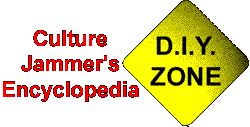By the official rules of billboards, someone pays rent on the sign for
a time, and by doing so can put an image there that turns our
neighborhoods into advertising supplements.
Billboard
liberation suggests that our eyeballs and our neighborhoods can be
reclaimed and that a billboard can be transformed from being yet another
ad into an explicit critique of advertising and consumerism, or even
into art.
This page introduces a further evolution of billboard liberation.
The idea is to transform a billboard from being a medium for a single
message — either one purchased by an advertiser or government, or
one injected by a billboard liberator — to being a medium for
multiple, changing messages from anyone in the community.

|
Here’s the billboard we targeted. The brooding ego and well-shaven
torso of the popular musician of the month. No more annoying perhaps
than most other billboards, but certainly ripe for our intended
improvements. “Maybe he deserves” a
chance to express some of the thoughts behind that pensive expression.
|
|
First, we covered over the text of the ad with paint to match the
preëxisting background color. Note the painters caps, coveralls,
and orange vest. Not shown in the picture are a handful of orange
traffic cones. For operations like this, I recommend doing it in
broad daylight and looking like you’re just doing your job. A
clipboard with some forms on it is another good prop.
|

|

|
There’s a type of spraypaint that turns the painted surface into a
chalkboard, just like the chalkboards in a classroom. We used
“Krylon Chalk Board Paint” in green, since the background of
the billboard was mostly black to start out with, but they also have a
black chalkboard paint.
We added “thought bubble” ovals in white. Then we filled in
the larger bubble with the chalkboard paint and repainted its border.
|





























